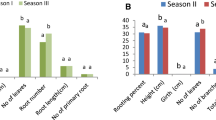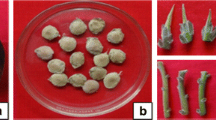Abstract
Dalbergia latifolia Roxb. is a premium-quality high-priced timber species of poor rooting ability restricting the propagation of its superior germplasm. Non-sustainable exploitation of the species left its natural population dwindling and vulnerable (VU) status. Despite its high market value, its occurrence is sporadic in natural forests and plantations are ‘rare’ in central India. With the aim of improvement in rooting ability, the seedling progeny of 10 selected superior germplasm of D. latifolia was raised for propagation through juvenile shoot cuttings. Progeny was hedged yearly in the last week of April and juvenile shoot cuttings were used for the experiment. With the varying rooting ability of progenies, an average of 35.83% adventitious rooting was achieved in shoot cuttings from 1 to 2 year-old progenies with basal dip treatment of 2.0mM IAA which gradually decline in successive years. 4–5 years old progenies exhibited 30.33% adventitious rooting with basal dip treatment of 5.0mM IAA. Further reduction in adventitious rooting was recorded in cuttings from 8 to 9 years and 10–11 years old progenies that exhibited 26.33% and 27.00% adventitious rooting with basal dip treatment of 5.0mM IAA + 1.0mM Boric Acid. Endogenous indole-3-acetic acid (IAA) available at the base of cuttings exhibited a non-significant relationship with the rooting ability for progenies of different ages. Besides, transport and availability of exogenously applied rooting hormone regulate the lateral movement of endogenously available IAA to the target cells in the pericyclic region substantially promoting the induction of adventitious rooting. Therefore, the use of juvenile shoot cuttings from progenies of selected trees was the most efficient procedure for the production of quality planting stock of Dalbergia latifolia.


Similar content being viewed by others
Availability of data and material
Data available with the senior author and planting material available in the nursery and field.
Code Availability
Bartlett test used.
References
Andersen, A. S. (1986). Stock plant conditions. In M. B. Jackson (Ed.), New root formation in plants and cuttings (pp. 223–255). Dordrecht/Boston/Lancaster: Martinus Nijhoff
Ansari, S. A., Pramod Kumar, P., & Mandal, A. K. (1995). Effect of position and age of cuttings and auxins on induction and growth of roots in Dalbergia sissoo Roxb. Indian Forester, 121(3), 201–206
Ansari, S. A., Sharma, S., Pant, N. C., & Mandal, A. K. (2002). Synergism between IBA and thiamine for induction and growth of adventitious roots in Tectona grandis. Journal of Sustainable Forestry, 15, 99–112
Ansari, S. A., Singh, S., & Abha Rani. (2004). Inorganic salts influence IAA ionization and adventitious rhizogenesis in Pongamia pinnata. Journal of Plant Physiology, 161, 117–120
Blakesley, D., Weston, G. D., & Hall, J. F. (1991). The role of endogenous auxin in root initiation. Part I. Evidence from studies on auxin application and analysis of endogenous levels. Plant Growth Regulators, 10, 341–354
Blakesley, D. (1994). Auxin metabolism and adventitious root formation. In T. D. Davis and B. E. Haissig [eds.], Biology of adventitious root formation, 143– 154. Plenum Press, New York, New York, USA
Chandra, J. P., & Gandhi, J. N. (1995). Rootings of cuttings of. Gmelina arborea. Indian Forester, 121, 427–428
Da Costa, C. T., de Almeida, M. R., Ruedell, C. M., Schwambach, J., Maraschin, F. S., & Fett-Neto, A. G. (2013). When stress and development go hand in hand: main hormonal controls of adventitious rooting in cuttings. Frontiers in Plant Science, 4, 133
Davis, T. D., Haissig, B. E., & Sankhla, N. (1988). In T. R. Dudley (Ed.), Adventitious root formation in cuttings. Vol II Portland, Oregon: Dioscorides Press. Advances in plant sciences series
Davis, T. D., & Haissig, B. E. (1990). Chemical control of adventitious root formation in cuttings. Plant Growth Regulators Society America Quart, 18, 1–18
De Klerk, G. J., Guan, H., Huisman, P., & Marinova, S. (2011). Effects of phenolic compounds on adventitious root formation and oxidative decarboxylation of applied indole acetic acid in Malus ‘Jork 9’. Plant Growth Regulation, 63, 175–185
Delbarre, A., Muller, P., Imhoff, V., & Guern, J. (1996). Comparison of mechanisms controlling uptake and accumulation of 2,4-dihydroxyphenoxy acetic acid, naphthalene-1-acetic acid and indole-3-acetic acid in suspension-cultured tobacco cells. Planta, 198, 532–541
Diaz-Sala, C. (2020). A perspective on adventitious root formation in tree species. Plants, 9, 1789–1796
Eriksen, E. N. (1974). Root formation in pea cuttings. II: The influence of indole-3-acetic acid at different development stages. Physiologia Plantarum, 30, 158–162
Ford, Y. Y., Bonham, E. C., Cameron, R. W. F., Blake, P. S., Judd, H. L., & Harrison-Murray, R. S. (2001). Adventitious rooting: examining the role of auxin in an easy-and a difficult-to-root plant. Plant Growth Regulators, 36, 149–159
Gasper, T., Kevers, C., Hausman, J. F., Rerthon, J. Y., & Ripetti, V. (1992). Practical uses of peroxidase activity as a predictive marker of rooting performance of micropropagated shoots. Agronmie 12, 757–765
Gasper, T., Kevers, C., Hausman, J. F., Rerthon, J. Y., & Ripetti, V. (1994). Peroxidase activity and endogenous free auxin during adventitious root formation. In P. J. Lumsden, J. R. Nicholas, & W. J. Davis (Eds.), Physiology, growth and development of plants in culture. Kluwer Academic Publishers
Gasper, T., Kevers, C., & Hausman, J. F. (1997). Indissociable chief factors in the inductive phase of adventitious rooting. In W. Altman (Ed.), Biology of root formation and development. New York: Plenum Press
Haissig, B. E., & Davis, T. D. (1994). An historical evaluation of adventitious rooting research to 1993. In T. D. Davis, & B. E. Haissig (Eds.), Biology of root formation (pp. 275–331). New York: Plenum Press
Hartmann, H. T., Kester, D. E., Davies, F. T., & Geneve, R. L. (2002). Plant Propagation Principles and Practices.7th Edition. Prentice Hall. New Jersey, pp. 367–374
Heloir, M. C., Kevers, C., Hausman, J., & Gasper, T. (1996). Changes in the concentrations of auxins and polyamines during rooting of in vitro propagated walnut shoots. Tree Physiology, 16, 515–519
Howard, B. H. (1994). Manipulating rooting potential in stock plants before collecting cuttings. In T. D. Davis, & B. E. Haissig (Eds.), Biology of root formation (pp. 123–142). New York: Plenum Press
Husen, A., & Pal, M. (2007). Metabolic changes during adventitious root primordium development in Tectona grandis Linn. F. (teak) cuttings as affected by age of donor plants and auxin (IBA and NAA) treatment. New Forest, 33, 309–323
Kevers, C., Hausman, J. F., Faivre-Rampant, O., Evers, D., & Gasper, T. (1997). Hormonal control of adventitious rooting progress and questions. Journal of Applied Botany, 71, 71–79
Kadambi, K. (1954). The silviculture of Dalbergia latifolia. Monograph of Indian Trees, No. 1. Government of India. Delhi: Manager of Publications
Klerk, G. J. D., Krieken, W. V. D., & Jong, J. C. (1999). The formation of adventitious roots: New concepts, new possibilities (Review). In Vitro Cell Development and Biology of Plant, 35, 189–199
Legue, V., Rigal, A., & Bhalero, R. P. (2014). Adventitious root formation in tree species: involvement of transcription factors. Physiologia Plantarum, 151, 192–198
Mitchell, R. G., Zwolinski, J., & Jones, N. B. (2004). A review on the effects of donor maturation on rooting and field performance of conifer cuttings. Southern African Forestry Journal, 201, 53–63
Nag, S., Saha, K., & Choudhuri, M. A. (2001). Role of auxin and polyamines in adventitious root formation in relation to changes in compounds involved in rooting. Journal of Plant Growth Regulation, 20, 182–194
Nahlawi, N., & Howard, B. H. (1973). The effects of duration of the propagation period and frequency of auxin treatment on the response of plum hardwood cuttings to IBA. Journal of Horticulture Science, 48(2), 169–174
Olatunji, D., Geelen, D., & Verstraeten, I. (2017). Control of endogenous auxin levels in plant root development. International Journal of Molecular Sciences, 18(12), 2587–2615
Osterc, G., & Stampar, F. (2011). Differences in endo/exogenous auxin profile in cuttings of different physiological ages. Journal of Plant Physiology168,2088–2092
Palanisamy, K., & Pramod Kumar. (1996). Seasonal effect on induction of adventitious rooting in stem cuttings of neem (Azadirachtaindica A. Juss.). Indian Journal of Forestry, 19, 183–186
Pizarro, A., & Díaz-Sala, C. (2019). Cellular dynamics during maturation-related decline of adventitious root formation in forest tree species. Physiologia Plantarum, 165, 73–80
Pop, T. I., Pamfil, D., & Bellini, C. (2011). Auxin control in the formation of adventitious roots. Notulae Botanicae Horti Agrobotanici Cluj-Napoca, 39(1), 307–316
Kumar, P., Jharia, S. K., & Ansari, S. A. (2011). Change in pH regimes and adventitious root induction in semi-hardwood cuttings of Gmelina arborea Roxb. Plant Growth Regulation, 65(3), 531–536
Ramussen, A., & Hunt, M. A. (2010). Ageing delays the cellular stages of adventitious root formation in pine. Australian Foresry, 73, 41–46
Ramussen, A., Hosseini, S. A., Hajirezaei, M. R., Druege, U., & Geelen, D. (2015). Adventitious rooting declines with the vegetative to reproductive switch and involves a changed auxin homeostasis. Journal of Experimental Botany, 66(5), 1437–1452
Steffens, B., & Ramussen, A. (2016). The physiology of adventitious roots. Plant Physiology, 170, 603–617
Stevens, M. E., Woeste, K., & Pijut, P. M. (2018). Localized gene expression changes during adventitious root formation in black walnut (Juglans nigra L.). Tree Physiology, 38, 877–894
Stoessl, A., & Venis, M. A. (1970). Determination of sub-microgram levels of Indole-3- acetic Acid. Analytical Biochemistry, 34, 344–351
Stuepp, C. A., Zuffellato-Ribas, K. C., Wendling, I., Koehler, H. S., & Bona, C. (2014). Vegetative propagation of mature dragon trees through epicormic shoots. Bosque, Valdivia,35(3), 337–345
Tewari, D. N. (1995). A monograph on Rosewood: Dalbergia latifolia Roxb. Dehradun: International Book Distributors. pp74
Troup, R. S. (1921). The silviculture of Indian trees (I vol., pp. 318–325). Clarendon: Oxford
Wiesmann, Z., Riov, J., & Epstein, E. (1988). Comparison of movement and metabolism of indole-3-acetic acid and indole-3-butyric acid in mung bean cuttings. Physiologia Plantarum, 74, 556–560
Wiesmann, Z., Riov, J., & Epstein, E. (1989). Characterization and rooting ability of indole-3-butyric acid conjugates formed during rooting of mung bean cuttings. Plant Physiology, 91, 1080–1084
Wilson, P. J. (1994). The concept of a limiting rooting morphogen in woody stem cuttings. Journal of Horticulture Science, 69(4), 91–600
Wong, C. V., & Jones, N. (1986). Improving tree form through vegetative propagation of Gmelina arborea. Commonwealth Forestry Review, 65, 321–324
Zalesny, R. S., Riemenschneider, E., & Hall, R. B. (2005). Early rooting of dormant hardwood cuttings of Populas: analysis of quantitative genetics and genotype x environment interactions. Canadian Journal of Forestry Research, 35, 918–929
Zargar, A. R., Dinesh, & Kumar (2018). Effect of maturity stage of donor plant on propagation of Diploknema butyracea through branch cuttings. World Journal of Agriculture Research, 6(1), 15–19
Acknowledgements
The senior author is grateful to the Indian Council of Forestry Research and Education, Dehradun for financial assistance by award of projects [Project ID: 131/TFRI-2008/GEN-1(17) and 227/TFRI/2016/Gen-2(33)]
Funding
Study was conducted under the projects funded by the Indian Council of Forestry Research and Education, Dehradun [Project ID: 131/TFRI-2008/GEN-1(17) and 227/TFRI/2016/Gen-2(33)]
Author information
Authors and Affiliations
Contributions
Senior author (PK) planned and executed experiments and IAA assay, analyzed data and prepared manuscript, PKP and MKS supervised experiments, helped in data collection and laboratory estimation of IAA and provided technical inputs in manuscript writing.
Corresponding author
Ethics declarations
Conflict of interest/competing interests
Authors declare no conflict of interests among them.
Ethics approval
Approval not required. Others ethics have been followed.
Consent for publication
Necessary consent for publication has been obtained.
Additional information
Publisher’s note
Springer Nature remains neutral with regard to jurisdictional claims in published maps and institutional affiliations.
Rights and permissions
About this article
Cite this article
Kumar, P., Patel, P.K. & Sonkar, M.K. Propagation through juvenile shoot cuttings in difficult-to-root Dalbergia latifolia – examining role of endogenous IAA in adventitious rooting. Plant Physiol. Rep. 27, 242–249 (2022). https://doi.org/10.1007/s40502-022-00664-x
Received:
Accepted:
Published:
Issue Date:
DOI: https://doi.org/10.1007/s40502-022-00664-x




